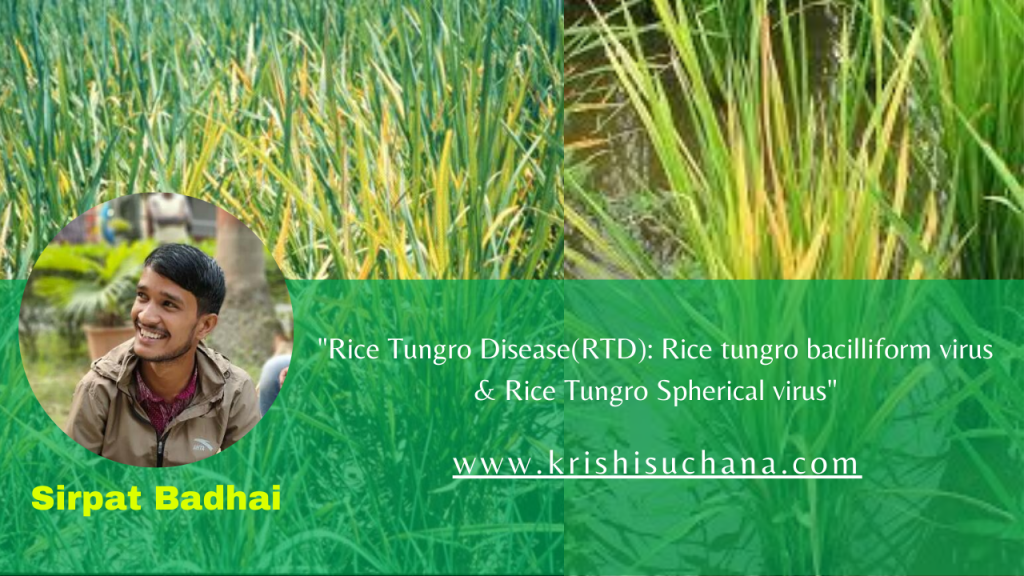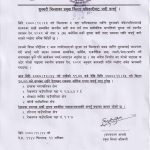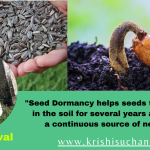Tungro disease of rice, it’s Economic Importance & Management Practice’s

Rice Tungro Disease(RTD): Rice tungro bacilliform virus & Rice Tungro Spherical virus
Economic importance
The mentak disease of Indonesia is also identified as Tungro. Tungro is commonly found in Bangladesh and India. In India, it is seen in states of West Bengal, Kerala and other parts of India. Tungro is one of the most widely distributed and most destructive diseases in tropical Asia. The loss was estimated during 1940 as 30% or 1.4 million hectares annually. In Thailand a severe epidemic occurred in 1966 affecting more than 3 lakh hectares. An
outbreak of Tungro in 1971 affected hudred and thousands of hectares in Phillippines. In Nepal Rice Tungro virus which is commonly known as rate rot (red disease )Or tungro which was firstly reported from parawanipur of Bara
district. Rice tungro virus disease infected plants gave 88.9% of loss grain than that of grain from healthy plants. The loss upto 22.9% is obtained due to shorter plant height, 16.3 % from smaller panicles, 67% from smaller number of effective tillers and 85.9% from lesser filled grains when plants are infected by tungro virus compared to that of healthy plants.
Symptoms
Infection occurs both in the nursery and in the main field. Plants are markedly stunted. Stunting is more severe on susceptible varieties and slight on more resistant varieties. Leaves show yellow to orange discoloration and interveinal chlorosis. Yellow discoloration is commonly seen in “Japonica” varieties, while “Indica” varieties show orange discoloration. Yellowing starts from the tip of the leaf and may extend to the lower part of the leaf blade. Young leaves are often mottled with pale green to whitish interveinal stripes and the old leaves may have rusty streaks of various sizes. The plants may be killed if infected early. Tillering is reduced with poor root system. The infected plants have few spikelets and panicles are small with discoloured grains.
Special detection techniques :
100ml of water for 15-30 minutes or 10 ml of tincture iodine + 140 ml of water for one hour, washed in water and
when examined.
Disease cycle
The virus causes severe damage only in area where the host plants and the insect vector multiply the year round. In the areas where the rice is not grown continuously, collateral hosts, especially wild rice are probable sources of
inoculum. Stubbles of infected plants from the previous season also serve as a source of inoculum. Grassy weeds such as Eleusine indica, Echinochloa colonum, Echinochloa crusgalli may be infected occasionally. The leafhoppers
viz, Nephotettix virescens, N. nigropictus, N. parvus, N.malayanus and Recilia dorsalis transmit the virus in a non-persistent manner.
Management of Rice tungro virus :
Cultural methods :
Mechanical methods:
Light traps are to be set up to attract and control the leaf hopper vectors as well as to monitor the population.
This should be practiced every day.
Chemical methods:
Leaf yellowing can be minimized by spraying 2 % urea mixed with Mancozeb at 2.5 gm/lit.
Spray two rounds of any one of the following insecticides :
Monocrotophos 36 wse (40ml/ha)
Fenthion 100 EC (40ml/ha) may be sprayed 15 & 30 days after transplanting. The vegetation on the bounds should also be sprayed with the insecticides. Maintain 2.5 cm of water in the nursery and broadcast anyone of the following is 20 cents, Carbofuran 3G 3.5 kg or phorate 10G 1.0 kg or Quinalphos 5G 2kg in nursery when virus infection is low. Apply Carbofuran granules @1kg/ha to control population.
During pre-tillering to mid-tillering when one affected hill/m is observed apply Carbofuran granules @3.5kg/ha or spray Monocrotophos @1.6 to 2.2ml/lit to control insects vector.
Biological methods :
Two fungi,Beauveria bassiana & paecilomyces a moeneroseus are reported as parasites of rice green leaf hopper, Nephotettix virescence. Spray of conidias suspension of the fungi on rice plants kills the
vector.
Causal Organism Biocontrol agents
Tungro – Rice Tungro virus – P. Fluorescence
Vector – Nephotettix ssp. For vector
Writer : Sirpat Badhai, Bsc (hons)Ag from institute of agricultural sciences Banaras Hindu university u.p.221005, India

 एउटा यस्तो विषालु भ्यागुता, जसको मुल्य नै पर्छ ३ लाख, जान्नुहाेस्
एउटा यस्तो विषालु भ्यागुता, जसको मुल्य नै पर्छ ३ लाख, जान्नुहाेस्  भोलि र पर्सि बालबालिकालाई भिटामिन ए खुवाइदै
भोलि र पर्सि बालबालिकालाई भिटामिन ए खुवाइदै  खगराज अधिकारी गण्डकीको मुख्यमन्त्री नियुक्त
खगराज अधिकारी गण्डकीको मुख्यमन्त्री नियुक्त  सुनसरीमा दुवै पक्षबीच सहमति, कर्फ्यु खुकुलो हुदै
सुनसरीमा दुवै पक्षबीच सहमति, कर्फ्यु खुकुलो हुदै  स्टेफेनको शतकमा आयरल्याण्ड वोल्भ्सले नेपाल ए लाई दियो २८५ रनको लक्ष्य
स्टेफेनको शतकमा आयरल्याण्ड वोल्भ्सले नेपाल ए लाई दियो २८५ रनको लक्ष्य 


